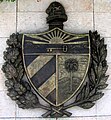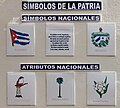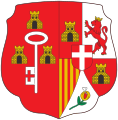Cuban coat of arms
The Cuban coat of arms, known as the La Palma Real, was created in 1849 by Miguel Teurbe Tolón —who also created the Cuban flag— at the request of General Venezuelan Narciso López, to seal the dispatches and bonds that he issued between 1850 and 1851 as head of the provisional government of Cuba.
The current version is not exactly the same as the original, since some elements that it contained and that could have been associated with annexationist ideas were suppressed. The design specifications of the shield were established by decree by the first president of Cuba, Tomás Estrada Palma, on April 21, 1906 and have remained unchanged ever since.
According to Law 42 of the National Assembly, it is the Symbol of the Nation. This shield has the shape of an ogival shield, and is divided towards two thirds of its height where a horizontal line ends it. In its upper part, the main one, there is a sea whose sides are two land portions (Florida and Yucatán), between which a solid stem key closes the strait (Cuba), with the lever downwards and at the bottom of which a Rising sun spreads its rays across the entire sky of the landscape. These elements symbolize the geographical and political importance of CUBA. The key represents the entrance to the Gulf of Mexico and the terrestrial meanings are from left to right, Cape Sable in Florida and Cape Catoche in Mexico. In the background, the sun appears half-sunken on the horizon, denoting its tropical heat.
The lower left quarter represents the division of the Island, that is, the Departments into which it was divided at that time, West, Center and East; representing them with three turquoise blue stripes. Two white ones, which expose the purity of their patriots, interspersed between the three blue ones, close the contents of the compartment. In the lower right quarter stands a royal palm, with the button of its central leaf at the top, as a symbol of the freshness and fertility of its privileged soil, as well as exposing that it has been the most useful of trees. through the history of that country. In the background, in his rear, two mountains appear. And light cloudscapes frame the landscape.
As a support, a bundle of rods, peeking out from below the vertex of the ogive and later appearing in the upper and central part of the axis of the shield, crowned with a red Phrygian cap, turned to the left, in which is embedded with a pentagonal star, facing upwards. The cap is an emblem adopted by the French Revolution, turned to the right, protruding from the top. This cap had been used in ancient times to be worn by men who had obtained freedom; In it, a white five-pointed star appears in its central part, with one of them oriented towards the top and, as in the Lone Star Flag, represents the independent state. The bundle of rods indicates the union of the Cubans; the star, the maximum expression of freedom.
And the ornamentation of the shield ends, always seen from the front, from left to right, without exceeding its height, a branch of oak, which represents peace, and another of laurel, which represents victory, tilting the contour of the same.
The shield was ratified by the 1940 Constitution and has been successively ratified in the Constitutions adopted after the triumph of the Cuban Revolution in 1959.
Gallery of shields
Historical evolution of the shield
Contenido relacionado
Arsinoe IV
Las Meninas
Kenneth Thompson




